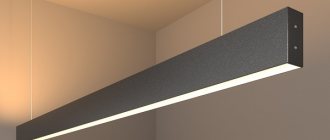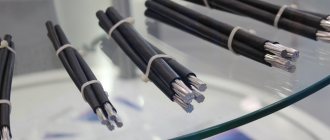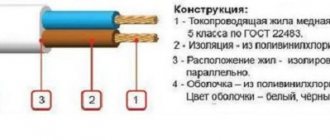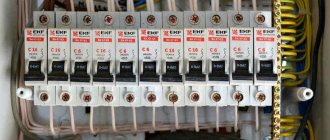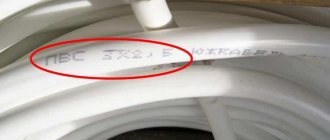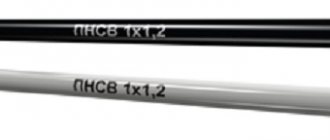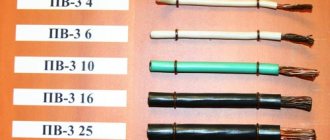KVVG cable is a multi-core copper or aluminum conductor used for remote control and automation control circuits. Due to the nature of its application, as well as limitations on the voltage and frequency of the current flowing through it, it occupies an intermediate position between high-voltage power cables and low-current communication lines. The decoding of the KVVG cable marking, what technical characteristics it has, where and for what purposes it is used will be discussed in this article.
Wire type KVVG
Explanation of the designation
The marking of a wire of this type consists of two blocks: alphabetic (consisting of 4-8 letters) and digital (two numbers separated by the multiplication sign “×”).
The designation (abbreviation) of the simplest wire KVVG 4×1 is deciphered as follows:
- “K” – the cable is a control cable;
- “B” - a material such as polyvinyl chloride plastic compound (PVC plastic compound) is used as insulation for the internal cores of the conductor;
- “B” – the outer insulation of the entire conductor (sheath) is made of PVC plastic;
- “G” – the cable does not have a special protective outer coating (can also be interpreted as “bare”).
The number block indicates the number of cores and the nominal cross-section of each of them. In this case, the wire contains 4 cores, each of which has a cross-section of 1.0 mm.
In addition to the basic symbols indicated above, the marking may also contain the following additional letters:
- “E” - the cable has a screen (a layer of aluminum foil and copper mesh located between the external insulation and the internal current-carrying conductors), which provides protection against the occurrence of induced voltage (noise) in it from nearby high-voltage power lines;
- “NG” - the material used for internal and external insulation has reduced flammability;
- “NG-LS” - the internal and external insulation of the wire, when melted, releases a small amount of harmful gases and smoke;
- “(A)” – the insulating material does not propagate fire;
- “C” - the internal current-carrying conductors of the control wire are color-coded.
On a note. If in the marking of this control wire there is a letter “A” before the mandatory letter block “КВВГ”, this means that the internal current-carrying conductors are made of aluminum. If there is no such letter in the marking, then the conductive elements of the cable are made of copper.
Cabling
It can also be laid externally in channels and trays made of brick, concrete, reinforced concrete and even in an earthen trench. In the case of laying in a trench, the fine fraction of the soil being removed should be placed on one side of the trench, and the coarse fraction and asphalt on the other.
The trench is filled not with excavated soil, but with sand. Under the cables at the bottom of the trench, it is necessary to provide a special cushion of fine sand with a height of at least 10 cm. If it is laid in difficult places (there are tree roots, large objects in the ground, increased periodic load from frequently passing vehicles, intersections with other switching routes of the gas pipeline, heat supply , water supply, etc.), then it must be “dressed” in a plastic pipe and used as a protective hose or for this purpose a plastic corrugation in the form of a kind of case.
The earthen trench must be filled with soil compaction and a small mound must be provided along the entire length of the cable route for possible subsidence. When laid aerially along the street, it is attached to a supporting cable, which is pulled between supports or from one building to the next.
Design and differences from power wires
KRPT cable
Structurally, the KVVG wire consists of the following parts:
- Core - the central part of the cable, consisting of one or more single-wire insulated conductors.
- Layers are several rows of conductive insulated conductors located radially around the core. Among the cores of one layer, there must be a counting pair - two conductors with red and blue insulation. The counting pair serves as a guide when connecting the remaining wires to various devices and sensors.
- Belt insulation - thin polyethylene or polyamide film, special paper (cable or telephone) located between the layers and the outer shell.
- Outer sheath - external insulation that does not have color markings and protects the cable and the current-carrying internal part of the control line from environmental influences.
In shielded KVVGE cables, between the outer sheath and the belt insulation there is a radial layer of aluminum or copper foil.
Structure of the KVVG control cable
The main differences between the KVVG cable and its power analogues include the following:
- Maximum voltage – conductors of the KVVG brand, unlike power analogues VVG, when passing alternating current through them, are capable of operating normally at a voltage of no more than 660 V (0.66 kV).
- Low resistance to breakdown voltage - the control wire of this brand must withstand a voltage of 2.5 kV for 5 minutes, while the power wire can withstand a current of 3 kV for 10 minutes.
- Color marking of conductors - in each layer there are 3 types of conductive conductors: a counting pair consisting of 2 conductors (blue and red); the remaining conductors having a color marking different from that which the conductors of the counting pair already have.
- Twisting of cores into layers - in control wires of this type, unlike power analogues, the internal cores are twisted around the core into radial layers, which are called layers (twists).
- Maximum heating temperature - the internal single-wire conductors of the KVVG cable can withstand heating up to a temperature of 700C, while power analogues can heat up to 75-800C;
- Insulation thickness – for a control cable of this type, the thickness of the external and internal insulation is on average 20-30% less than for power cables.
- Elasticity - the minimum bending radius of the control conductor ranges from 3 to 6 of its outer diameters, while for power conductors it is only 10-12.
Such a large list of differences is complemented by one more - the low cost of KVVG brand cables compared to power cables.
Using KVVG
From the very name “control cable” or “control cable” it is not difficult to guess that this type of wire was originally intended for use in electrical circuits for monitoring or control.
In addition, as can be seen from the wide range of wires, there are many “not low-current” ones, thanks to which KVVG can be used to control contactors with high load and power, as well as to collect readings from limit switch sensors.
Also, the capabilities of the wire allow it to cope with the load of electric motors and other executive action motors. However, we recommend connecting them via power wires.
Specifications
SIP cable 2: technical characteristics
KVVG cables have the following technical characteristics:
- Number of cores – from 4 to 37-61;
- The nominal cross-section of one core is from 0.75 to 4-6 mm2;
- Outer diameter – from 7.7 to 29.3 mm;
- Weight – from 78 to 1876 kg/km;
- Operating temperature range – from -50 to +500С;
- Relative air humidity at a temperature of 35 0C – 98%;
- Limit voltage and frequency of alternating current – 660 V and 100 Hz;
- Test voltage – 2,500 V;
- Maximum DC voltage – 1000 V;
- Electrical insulation resistance of the cores is from 6 to 10 mOhm/km;
- The thickness of the insulating layer of the cores is 0.6-0.9 mm;
- Maximum heating temperature – 700C;
- The minimum bending radius is from 6 to 3 outer diameters;
- Construction length – 150 m;
- Warranty period – 36 months.
Also, another important characteristic of such wires is the minimum laying temperature without preheating. For KVVG brand wire it is -15 0C.
Dimensions of the main types of KVVG wires
Important! The characteristics of control cables are determined by such regulatory documents as GOST 1508-78 and 26411-85.
Price
From us you can get the most favorable commercial offer when purchasing any type of cable and wire products. We invite you to choose a product from the presented range, as well as place an order for production. We work with individuals and legal entities, supply materials throughout Russia and are able to offer the lowest cost to our regular customers.
To buy a KVVG cable, you must leave a request on the website or send it by email. You can get detailed information about the products from our consultants. At the same time, with each order we supply a certificate of conformity and a quality passport, which indicates the originality of the product and its high characteristics.
Manufacturers
The main manufacturers of these cable products include such enterprises as:
- LLC "TD RT-Cable";
- JSC "Belaruskabel";
- LLC "TD Voronezhtelekabel";
- JSC "Cable"
- Rybinskkabel LLC;
- JSC Sibkabel;
- LLC "HKA";
- LLC "GK "Sevkabel"
Among foreign manufacturers of such an analogue of KVVG wire as NYM-O, the following are the most popular:
- "Nexans";
- "Denizli Cable";
- "TKD Kabel".
Installation
This type of control wire is laid in two ways:
- Closed - in reinforced concrete and concrete trays, tunnels, corrugated polyethylene pipes. The laying depth ranges from 0.5 to 0.7 meters;
- Open - in closed metal, plastic trays, boxes.
Reinforced concrete trays for laying control lines
The use of a closed installation method is more preferable, since it allows you to protect the control lines from the influence of the external environment.
Important! To avoid damage when laying in an open way, it is recommended to avoid sagging and strong tension in the line.
Despite the apparent ease of installation and relative safety of control lines, their installation should be carried out by qualified technical personnel with relevant experience and knowledge in this type of work. Independent installation and connection of such wires can lead to negative consequences.
Application area
KVVG refers to control cables, their scope of application is control circuits and control circuits. At the same time, the wide size range indicates that it is not low-current. Its main purpose is to control any, even powerful contactors, and receive information from sensors and limit switches.
Technical characteristics allow you to withstand the operation of actuators, such as heat guns and electric motors, but power cables are better suited for connecting them.


